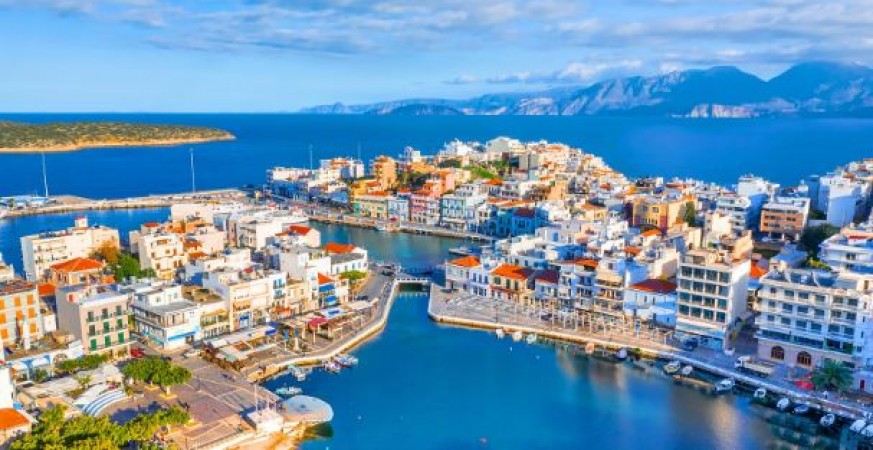
Crete, the largest and most populous of the Greek islands, is a land shrouded in myth and history. Situated in the southern part of the Aegean Sea, Crete has been a cultural crossroad for millennia, fostering the development of one of the earliest advanced civilizations in Europe—the Minoan civilization. This vibrant island is not only renowned for its ancient past but also for its natural beauty, rich traditions, and warm hospitality. In this essay, we will delve into the captivating history, culture, geography, and contemporary life of Crete, providing an in-depth exploration of this alluring Mediterranean gem.
Crete boasts an area of approximately 8,300 square kilometers (3,200 square miles), making it the fifth-largest island in the Mediterranean. The island is characterized by a diverse landscape, ranging from rugged mountains to fertile plains, and stunning coastlines with golden sandy beaches. Its highest peak, Mount Ida (Psiloritis), rises majestically to an elevation of 2,456 meters (8,057 feet), offering breathtaking panoramas.
Also Read: Love on the Road: Inspirational Travel Quotes for Couples
Crete experiences a Mediterranean climate, with hot, dry summers and mild, wet winters. The island benefits from over 300 days of sunshine each year, making it an ideal destination for sun-seeking travelers. The coastal regions benefit from the cooling sea breeze, while the mountainous areas offer relief from the summer heat.
Crete's history is indelibly linked to the Minoan civilization, one of the most fascinating ancient cultures to have ever existed. Flourishing from approximately 3000 BCE to 1450 BCE, the Minoans left behind a wealth of archaeological treasures, many of which can be explored in the famed archaeological sites of Knossos, Phaistos, and Malia.
Also Read: Exploring the Timeless Beauty of Rome
The Minoans were skilled traders and seafarers, with an extensive network that connected Crete to various Mediterranean regions, including Egypt and Anatolia. Their advanced society boasted impressive architecture, sophisticated artwork, and a script, known as Linear A, which remains undeciphered to this day.
Minoan religious beliefs, often centered around goddess worship and fertility rites, contributed to the island's spiritual aura. The myth of the Minotaur, imprisoned in the Labyrinth beneath the Palace of Knossos, remains a captivating tale passed down through the ages.
Beyond the Minoan era, Crete's history has been shaped by various civilizations, including the Mycenaeans, Dorians, Romans, Byzantines, Arabs, Venetians, and Ottomans. Each civilization has left its mark on the island, contributing to the richness of its heritage.
Also Read: Montenegro: A Jewel of the Adriatic
The Byzantine period saw the establishment of numerous monasteries, some of which still stand today, serving as historical and religious landmarks. During the Venetian and Ottoman occupations, Crete became a strategic trading hub and experienced significant cultural influences from these empires.
The Cretan people have a long history of resistance against foreign rule. In the early 19th century, Cretans began their struggle for independence from the Ottoman Empire. A series of revolts ensued, with the most notable being the Great Cretan Revolution of 1866–1869, which led to the international recognition of Crete's autonomous status.
In the early 20th century, during the Balkan Wars and World War I, Crete's sovereignty was contested, resulting in its unification with Greece in 1913. However, the island's tumultuous journey toward complete integration into Greece continued during World War II, when it faced German and Italian occupation.
The people of Crete, known as Cretans, are immensely proud of their cultural heritage and traditions. Their identity is closely tied to a strong sense of independence, resilience, and hospitality. Traditional Cretan music, dance, and cuisine are vibrant expressions of their spirit.
Also Read: The beaches of Goa are perfect for monsoon vacations, definitely plan to travel this season
Cretan cuisine, considered one of the healthiest in the world, features olive oil, local vegetables, herbs, and cheese as staple ingredients. Visitors can savor delightful dishes such as dakos (rusk topped with tomato, cheese, and olive oil), staka (a type of local cream), and souvlaki (grilled meat skewers).
Throughout the year, Crete comes alive with numerous festivals and celebrations that showcase its cultural diversity. Easter, in particular, is a significant event, with local communities participating in unique religious processions and rituals. The Feast of Saint Titus in August and the Grape Harvest Festival in September are among the most popular festivities.
Crete is a thriving destination for travelers seeking a blend of history, relaxation, and natural beauty. The island's tourism industry has grown significantly over the years, with charming coastal towns like Chania, Rethymno, and Agios Nikolaos attracting visitors from all over the world.
Also Read: Danube River: Queen of Europe's Rivers
Besides its enchanting beaches, Crete's interior offers opportunities for outdoor enthusiasts, from hiking the Samaria Gorge to exploring ancient caves and archaeological sites. The island's winemaking and olive oil production continue to thrive, showcasing the region's culinary prowess.
Crete, Greece's jewel in the Mediterranean, is a treasure trove of history, culture, and natural wonders. Its ancient Minoan past laid the foundation for an enduring legacy that permeates the island's contemporary identity. With its breathtaking landscapes, warm-hearted people, and captivating traditions, Crete beckons travelers to embark on a mesmerizing odyssey, one that unites the past with the present in an experience like no other.
Also Read: Exploring Alsace: A Timeless Blend
The Mystique of Savitri Temple: A Spiritual Journey to Pushkar